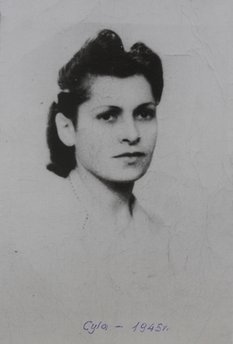-
News >World
Former inmate recalls daring escape from Auschwitz
2010-07-21 23:05NOWY TARG, Poland - With every step toward the gate, Jerzy Bielecki was certain he would be shot.
The day was July 21, 1944. Bielecki was walking in broad daylight down a pathway at Auschwitz, wearing a stolen SS uniform with his Jewish sweetheart Cyla Cybulska by his side.

In this 1945 photo Cyla Cybulska is seen. 60 years ago Cyla escaped from the Auschwitz Birkenau death camp with the help of her Polish boyfriend Jerzy Bielecki, also an Auschwitz prisoner. [Agencies]His knees buckling with fear, he tried to keep a stern bearing on the long stretch of gravel to the sentry post.
The German guard frowned at his forged pass and eyed the two for a period that seemed like an eternity _ then uttered the miraculous words: "Ja, danke" - yes, thank you - and let Jerzy and Cyla out of the death camp and into freedom.
It was a common saying among Auschwitz inmates that the only way out was through the crematorium chimneys. These were among the few ever to escape through the side door.
The 23-year-old Bielecki used his relatively privileged position as a German-speaking Catholic Pole to orchestrate the daring rescue of his Jewish girlfriend who was doomed to die.
"It was great love," Bielecki, now 89, recalled in an interview at his home in this small southern town 55 miles (85 kilometers) from Auschwitz.
"We were making plans that we would get married and would live together forever."Bielecki was 19 when the Germans seized him on the false suspicion he was a resistance fighter, and brought to the camp in April 1940 in the first transport of inmates, all Poles.
He was given number 243 and was sent to work in warehouses, where occasional access to additional food offered some chance of survival.
It was two years before the first mass transports of Jews started arriving in 1942. Most of the Jews were taken straight to the gas chambers of neighboring Birkenau, while a few were designated to be forced laborers amid horrific conditions, allowing them to postpone death.
In September 1943 Bielecki was assigned to a grain storage warehouse. Another inmate was showing him around when suddenly a door opened and a group of girls walked in.
"It seemed to me that one of them, a pretty dark-haired one, winked at me," Bielecki said with a broad smile as he recalled the scene. It was Cyla - who had just been assigned to repair grain sacks.
Their friendship grew into love, as the warehouse offered brief chances for more face-to-face meetings.
In a report she wrote for the Auschwitz memorial in 1983, Cybulska recalled that during the meetings they told each other their life stories and "every meeting was a truly important event for both of us."
Cybulska, her parents, two brothers and a younger sister were rounded up in January 1943 in the Lomza ghetto in northern Poland and taken to Auschwitz-Birkenau. Her parents and sister were immediately killed in the gas chambers, but she and her brothers were sent to work.
By September, 22-year-old Cybulska was the only one left alive, with inmate number 29558 tattooed on her left forearm.
As their love blossomed, Bielecki began working on the daring plan for escape.
From a fellow Polish inmate working at a uniform warehouse he secretly got a complete SS uniform and a pass. Using an eraser and a pencil, he changed the officer's name in the pass from Rottenfuehrer Helmut Stehler to Steiner just in case the guard knew the real Stehler, and filled it in to say an inmate was being led out of the camp for police interrogation at a nearby station. He secured some food, a razor for himself and a sweater and boots for Cybulska.
He briefed her on his plan: "Tomorrow an SS-man will come to take you for an interrogation. The SS-man will be me."
